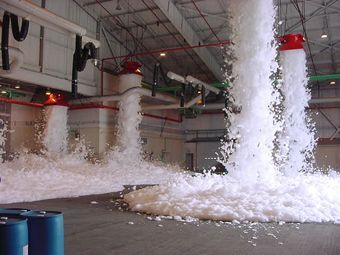Foam Suppression System
What is Firefighting foam ?

How the foam system works?

AFFF
Aqueous Film-Forming Foams (AFFF) are based on combinations of flouro-chemical surfactants, hydrocarbon surfactants, and solvents. This agent requires a very low energy input to produce a high quality fire fighting foam. Consequently, they can be applied through a wide variety of foam delivery systems. This versatility makes AFFF systems an obvious choice for airports, refineries, manufacturing plants, municipal fire departments, and any other operation involving the transportation, processing, or handling of flammable liquids
AR-AFF
ARCs are the most versatile of the foam agents in that they are effective on fires involving polar solvents like methanol as well as hydro-carbon fuels like gasoline. When used on a polar solvent type fuel, the ARC concentrate forms a polymeric membrane which prevents destruction of the foam blanket. When used on hydrocarbon fuels, the alcohol-resistant concentrate produces the same rugged aqueous film as a standard AFFF agent. Alcohol-resistant concentrates provide fast flame knockdown and good burn back

Mixing Foam with Water
A foam system requires proportioning equipment to mix the foam with water in the required concentration. Automatic pressure balancing valves regulate the foam concentrate pressure to match the water pressure
Bladder Tanks
Foam concentrate is often stored in a bladder tank system. In AFFF systems a bladder tank containing a nylon reinforced elastomric bladder is used to store the foam concentrate. System water pressure is used to squeeze the bladder providing fire fighting foam concentrate, at the same pressure, to the proportioner. With bladder tank foam systems, no external power is required, and little maintenance is needed.
ARC-Class B
Fluoroprotein Foam Concentrates
Fluoroprotein foams are based on hydrolyzed protein, stabilizers, preservatives, and synthetic fluorocarbon surfactants. When compared to protein foams, fluoroproteins provide better control and extinguishment, greater fluidity, and superior resistance to fuel contamination. Fluoroprotein foams are useful for hydrocarbon vapor suppression and have been recognized as very effective fire suppressing agents for sub-surface injection into hydrocarbon fuel storage tanks.
High Expansion Foam Concentrate
High expansion foams are based on combinations of hydrocarbon surfactants and solvents. They are used with foam generators for applying foam to large areas in total flooding and three-dimensional applications such as warehouses, ship cargo holds, and mine shafts. They are especially useful on fuels such as liquefied natural gas (cryogenic fuels) for vapor dispersion and control. In certain concentrations, high expansion foams are effective on hydrocarbon spill fires of most types and in confined areas



